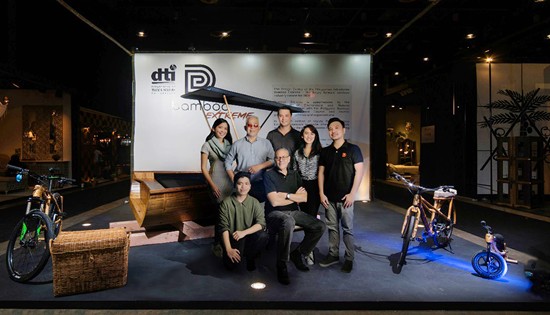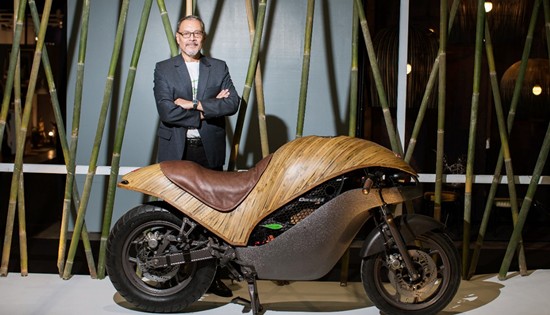|

The
Bamboo Extreme Design Team. Bamboo Extreme was handled by
designers and product specialists from Design Center of the
Philippines. (L-R, bottom row) Lemuel Abron, Chris Lacson,
(L-R, top row) Kate Añoso, Milo Naval, Bryan McClelland,
Lotti Galicia, and Ivan Limjoco. |
PH eco-motorcycle
recognized in WGSN’s Design Futures Report under Engineering Nature
By
DTI-TIPG-DCP
March 16, 2018
PASAY CITY – The
Department of Trade and Industry’s Design Center of the Philippines
sees Philippine design steadily rising into the international design
scene as locally-made eco-friendly motorcycle Green Falcon lands in
WGSN’s Design Futures Report.
“With Green Falcon and
Bamboo Extreme getting featured in WGSN, it pushes the Philippines’
status a notch when it comes to material and design innovation. It
celebrates the Philippine design industry’s capability to develop
products that are forward thinking, and potential in influencing
global design,” said Rhea O. Matute, Executive Director of
DTI-Design Center of the Philippines.
WGSN is an
internationally-renowned online trends forecasting portal, where
excellent research, data and insights are provided to help
businesses stay relevant, keep abreast of future trends, and tap
into their potential growth opportunities.
In WGSN’s report entitled
Engineering Nature, the Green Falcon was listed among other product
and material innovations that combined technology and engineering
with natural elements.
“Moreover, it recognizes
Design Center’s efforts, and in partnership with the Department of
Trade and Industry, in growing its vision for the Philippine design
industry,” added Matute.
The Bamboo Extreme is a
collaborative project between Design Center of the Philippines and
DTI-Industry Cluster Enhancement aimed at modernizing bamboo to
capture the millennials’ way of life, filled with adventure,
exploration, and experimentation.
Inspired by café racers in
the 1960s, the Green Falcon is notable for using bamboo for the
motorbike’s upper body, a first in the production of motorcycles. It
remarkably emphasized how bamboo as a material can be pushed beyond
the usual, normal, and traditional product applications such as
furniture, home accessories and lamps and lighting.
“What is highlighted in
the Green Falcon is a natural or organic ergonomic component in the
use of bamboo for the motorbike’s body shell,” designer Christopher
Paris Lacson says about the bamboo body shell. “It allows the rider
to feel comfortable sitting as he would on a wooden chair.”
Lacson especially designed
the Green Falcon for adventurous millennials, who highly regard
design, performance, and sustainability while supporting the
Philippine design industry as well. Mimicking the speed of a falcon,
the eco-friendly motorbike can put its gear to a speed of 100-110
kph. It also uses electricity for power, its contribution to zero
pollution on the road.
“What we are doing, with
bamboo and other raw material composites with technology, we are
breathing a new paradigm in materials. It is a paradigm breaker,”
Lacson explained about the combination of natural material and
technology. “I would like to think that this is something that is
hopefully at the edge of a new trend.”
While he believes
Filipinos are very creative people, he noticed how most Filipino
consumers would still look to other countries’ products, and not the
locally-made ones.
“It’s about time we shift
their perspectives on products – from Ducati to Banatti
[manufacturer of the Green Falcon], from foreign to local,” Lacson
remarked, wanting to inspire local industries and leaders to create
and develop more tools that can transport the country and its people
to inclusive growth. “I hope that other countries will begin looking
at us, and would want to try something from the Philippines.”
The Design Center of the
Philippines, and attached agency of the DTI, is the only national
agency for design, and the leading agency committed to cultivating a
culture that thrives in creativity, value creation, and innovation.
|

The
Green Falcon with designer Christopher Lacson. The prototype
was built by a small team composed of Prototype Engineer
Jess “Sparky” Alimbo, Body Sculptor Eddie “Bondo” Canete,
and Evolve/OMO Factory’s bamboo craftsmen. |